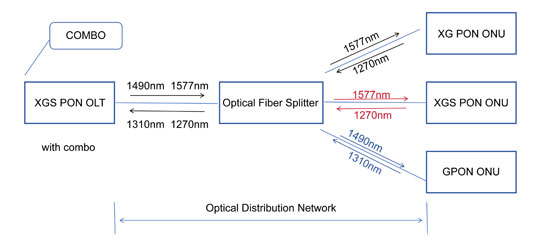GPON is a passive optical network (PON) access technology based on the ITU-T G.984.x standard. XG-PON and XGS-PON are the next generation 10G GPON that belongs to the evolution of GPON.XGS PON, XG PON and GPON are three types of passive optical network (PON) access technology. We will briefly and profoundly explain the Differences between GPON, XG-PON And XGS-PON and their Compatibility.
1.What Is GPON?
G stands for Gigabit,PON stands for passive optical network.GPON means a one Gigabit PON.
GPON technology is the latest generation broadband passive optical integrated access standard based on the ITU-TG.984.x standard.
The maximum rate of downlink is 2.5Gbps, and the maximum rate of uplink is 1.25 Gbps.
The upstream wavelength of GPON is 1310 nm, and the downstream wavelength is 1490 nm.
The maximum splitting ratio is 1:128.
2. What is XG PON?
X stands for 10.XGPON is a 10G GPON, which belongs to the GPON series.
The maximum rate of downlink is 10 Gbps, and the maximum rate of uplink is 2.5 Gbps.
The upstream wavelength of XG PON is 1270 nm and the downstream wavelength is 1577 nm.
The maximum splitting ratio is 1:256.
3. What is XGS PON?
S stands for Symmetry.XGS PON means a 10 Gigabit Symmetric PON.
XGS-PON also belongs to the GPON series. XGS-PON is the technological evolution of XG-PON.
XGS-PON is a symmetric PON.
The maximum rate of downlink is 10Gbps, and the maximum rate of uplink is also 10 Gbps
The upstream wavelength of XG PON is 1270 nm and the downstream wavelength is 1577 nm
The maximum splitting ratio is 1:256.
4. GPON vs XG PON vs XGS PON - What Are the Differences Among them?
|
GPON
|
XG PON
|
XGS PON
|
maximum rate of uplink
|
1.25 Gbps
|
2.5 Gbps
|
10 Gbps
|
maximum rate of downlink
|
2.5 Gbps
|
10 Gbps
|
10 Gbps
|
upstream wavelength
|
1310 nm
|
1270 nm
|
1270 nm
|
downstream wavelength
|
1490 nm
|
1577 nm
|
1577 nm
|
maximum splitting ratio
|
1:128
|
1:256
|
1:256
|
Since the user's uplink/downlink data is generally asymmetric, the main PON technologies currently used are GPON and XG-PON, both of which are asymmetric PON.
5.How is XGS PON OLT Compatible With GPON And XG PON ONU?
5.1XGS PON vs GPON - Compatible between OLT and ONU
XGS PON OLT can be connected to GPON ONU through the Combo solution.
The Combo optical module of XGS PON integrates WDM combiner, GPON optical module, XGS PON optical module.
In the upstream direction, after the optical signal enters the Combo port, WDM filters the XGS PON and GPON signal according to the wavelength, and afterward sends the signal to different ONU.

So XGS PON supports access of GPON, XG PON and XGS PON three types of ONU.
5.2 XGS PON vs XG PON - Compatible between OLT and ONU
Since the downstream wavelength and downstream rate of XG PON and XGS PON are the same, the downstream of XGS PON does not distinguish between XG PON ONU and XGS PON ONU, and each ONU chooses to discards other signals and receive its own signal.

Read more: Where 10G ONUs Fit In:Latest Trends in XGS-PON Technology
XGSPON ONU vs GPON ONU: Key Differences You Need to Know